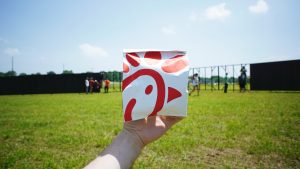Slogans: The Ultimate Communications Tool
Published on March 22, 2021, at 8:52 p.m.
by Caroline Robinson.
We know them; we sing them; we are surrounded by them, and we learn to love them. Everybody loves a good slogan, but it means much more than a saying or jingle that replays in our heads for a brand’s internal stakeholders. A slogan is defined as “a word or phrase used to express a characteristic position or stand or a goal to be achieved.” For some brands, it is the foundation of their advertising and communications efforts. Therefore, the slogan must remain consistent with a brand’s messaging.
“Eat Mor Chickin”:
This famous slogan coined by Chick-fil-A “began as the solution to an interesting problem.” In the early 1960s, Truett Cathy, the founder of Chick-fil-A, was approached by a local poultry supplier who had extra chicken breast pieces. Cathy decided to use the supplier’s offer as an opportunity, and thus was the birth of the original chicken sandwich.
Ever since, Chick-fil-A’s messaging has been a satire on chicken being superior to beef. In 1995, a figurine cow painted the words “Eat Mor Chickin,” and the slogan has stuck with the brand ever since.

Cassidy Ayers, marketing director of Chick-fil-A in Florence, Alabama, said that “Eat Mor Chickin” is a commentary on the lighthearted and family-friendly reputation that Chick-fil-A upholds. Through Chick-fil-A’s comedic messaging and celebration of “Cow Appreciation Day,” it has fully embraced the slogan as a way to sell its food products to consumers.
“We use ‘Eat Mor Chickin’ to relate to our guests during this time because even with life being crazy right now, we want our guests to know that our restaurant will always be consistent in their lives,” Ayers said about Chick-fil-A’s consistent slogan and branding.
A slogan plays an essential role in public relations because it directly impacts how consumers think and feel about a brand. According to SocialMediaToday, a slogan is skewed with a brand name and can act as a shadow of what the company is seeking to convey. Successful slogans should be complete thoughts that are emotionally attached and reliable.
“The Happiest Place on Earth”:
Since Disneyland opened in 1955, it has continuously brought fairy tales to life. People experience an extraordinary feeling when exploring Walt Disney World, and some describe this feeling as magical. Therefore, the brand’s slogan is representative of the immense joy that people experience when visiting.
The Sports Brand Solutions intern for Walt Disney World, Taylor Garner, said that the slogan portrays the stories that Disney tells as inspiring and joyful. Disney created the slogan to express consumers’ genuine joy that is difficult to put into words.

“When you see the advertisements for anything that Disney markets, you are instantly reminded of some memory associated with the movie, show or experience from either your childhood or now,” Garner said. Disney sets itself apart from its competitors by using its slogan to replicate people’s emotional experience with the park, characters, television series and overall brand.
Public relations has a large impact on how a brand is portrayed to target audiences. Garner explained that “good public relations can help establish and maintain brand loyalty. You want people to come back and consume your products and support your brand.” When formulating a company’s brand identity, consumer loyalty is key. The company’s messaging should portray what it stands for and position it as caring about its consumers. Once a company earns its consumers’ respect, it can continue its messaging consistently and gain credibility as a reliable company.
Messaging is especially important to brands that capture lots of media attention. According to Garner, “for The Walt Disney Co., messaging is everything. The company is very large and always has eyes on it. Therefore, it is imperative to make sure that the content and messaging continue to reflect the brand, so consumers will continue to support us.” Remaining consistent and open with messaging is key to ensuring consumer loyalty.
Ayers emphasized that Chick-fil-A stays consistent with its communications because its employees want to be a constant vector for people. Chick-fil-A keeps up a friendly restaurant atmosphere that coincides with the product messaging portrayed by the playful cows. It has developed a unique brand for itself by using the slogan “Eat Mor Chickin” to be encompassed in every aspect of its messaging, including its logo of a chicken and cow mascots that encourage the consumption of “Mor Chickin.” Ayers said that the slogan is often used to capture people’s attention before a new product launch.
The connection between a brand’s image and its slogan is wholly intertwined, and the way key publics think about a company has more to do with the slogan than you may realize. Think about what emotion is elicited the next time you drive past your favorite store or fast-food chain, and you may realize that it is more than your favorite jingle or creative phrase.




